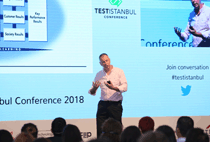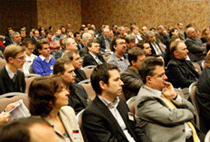Keynotes

Erik is a regular speaker both at national and international testing conferences and a leading international trainer in the field of software testing. As a keynote speaker, he has presented at conferences in America, Australia, Brazil, India, Malaysia, New-Zealand, Peru, South-Korea and throughout west and eastern Europe. At these conferences he often also runs tutorials.
The most important and most recent keynote presentations include:
 BUILDING ON SUCCESS – BEYOND THE OBVIOUS
BUILDING ON SUCCESS – BEYOND THE OBVIOUS
During this evolving presentation Erik discusses existing testing approaches, methods and techniques. Which ones really work, and which ones provide the most valuable contribution towards project success? It does not have to be perfect, often “good enough testing” is sufficient. Five important and indispensable recommendations are presented that every (Agile) project should implement in order to be successful and deliver business value. This presentation is based on many practical experiences in various domains.
“Enjoyed the range of topics and ideas; very helpful and something we all need to hear. Thank you for an inspiring talk!”
 TESTING CENTER OF EXCELLENCE
TESTING CENTER OF EXCELLENCE
Software will never be defect free. Testing is and will always remain an essential part of software development. During this presentation Erik will discuss five topics that together will take care of first-class testing. Based on the European Foundation for Quality Management (EFQM) model, leadership, policy and strategy, process, people and infrastructure & tools are presented. Finally some results that can be achieved following this approach are shown.
 TMMi: BUSINESS-DRIVEN AND KEEPING IT SIMPLE
TMMi: BUSINESS-DRIVEN AND KEEPING IT SIMPLE
The Test Maturity Model integration (TMMi) has a rapidly growing uptake, and is now the de-facto world-wide standard for test process improvement. An overview is provided of the TMMi model and the way TMMi supports business-driven test process improvement. The presentation addresses how specifically to implement TMMi succesfully by keeping it simple. Finally the business benefits (and costs) that can be achieved with TMMi will be discussed.
 TMMi RESULTS FROM THE WORLD-WIDE USER SURVEY
TMMi RESULTS FROM THE WORLD-WIDE USER SURVEY
The Test Maturity Model integration (TMMi) is now recognized by many as the world-wide standard for test process improvement. A brief overview of the TMMi model is provided. Together with their research partners, the TMMi Foundation, has performed a world-wide user survey of which the results have recently been published. During this presentation the most interesting results, e.g., where and how it is used, results and benefits achieved, costs of doing TMMi and challenges experienced, will be shared with the audience.
 RISK-BASED TESTING (FOR AGILE PROJECTS)
RISK-BASED TESTING (FOR AGILE PROJECTS)
This presentation discusses real-life techniques (PRISMA and Risk-Poker) for applying structured risk-based testing. It presents how risk identification and analysis can be carried out in close co-operation with stakeholders and the team. It also addresses ways on how the outcome of the risk analysis should be used to define a differentiated risk-based test approach. The techniques have been developed in practice, and has been tuned through many test projects in various domains. Practical experiences are discussed, together with problems encountered and results achieved.
 TEST STRATEGIES, ANALYTICAL TESTING AND MORE
TEST STRATEGIES, ANALYTICAL TESTING AND MORE
Software will never be defect free. At the same time the importance of software to the society, and it’s complexity are growing at a high rate. Just applying traditional testing practices in many cases in not enough anymore. This keynote will discuss the various test strategies that can be applied, and how they can assists the test professional. Special focus will be given to analytical testing. What is analytical testing and how can it be applied in today’s challenging projects? How does risk-based testing relate to analytical testing? These and many more questions will be dealt with during this keynote.
 THE ESSENTIALS OF STRUCTURED TESTING
THE ESSENTIALS OF STRUCTURED TESTING
Both the increasing importance of software in our society and the costs that are involved in testing, confirm the need for structuring the testing process. This presentation deals with the essential practices that are required for any structured testing process and the results that can be achieved when applying them. These essential practices offer general guidelines for all testing and can be used by IT-auditors as a checklist to evaluate the quality of the testing process.

